When you see comparisons between avocado varieties, often discussed are the flower type, size of the tree and its fruit, peel color, and cold sensitivity. Rarely, however, do you get a clue as to a variety’s sensitivity to heat.
(See, for example, Table 5 on page 30 of Book 1, Chapter 2 of “Avocado Production in California.”)
But in the last few years, I’ve noticed more avocado growers — commercial and backyard — inquiring about the heat tolerance of different varieties. Of course, the heat of July 6 and 7, 2018, which broke historical records across Southern California, especially fired up this concern.

I grow a few dozen varieties of avocado trees in my yard, and I’ll share observations of how certain trees fared during the July 2018 heat wave, as well as during a somewhat less extreme heat wave in 2016. I’ll add my observations of how other avocado trees of different varieties responded to the July 2018 heat event in other locations in Southern California. In addition, I’ll share the observations that other people have made of different avocado varieties dealing with high heat in Southern California and the San Joaquin Valley. Finally, I discuss how the idea of heat tolerance is not as straight forward as it might seem.
Before I go on, let me note that this post is not about helping avocado trees cope with high heat. That post is here: “Protecting avocado trees from heat.”
What is heat or high heat?
Of all the avocado varieties that I grow, none get significant damage on their leaves unless the temperature reaches over about 105 degrees, as long as the tree is well watered, healthy, and over about knee height. For example, my yard got up to 104 degrees last week (on July 11). The worst damage on a healthy avocado tree in my yard (in full sun, no protection) was taken by the Pinkerton.
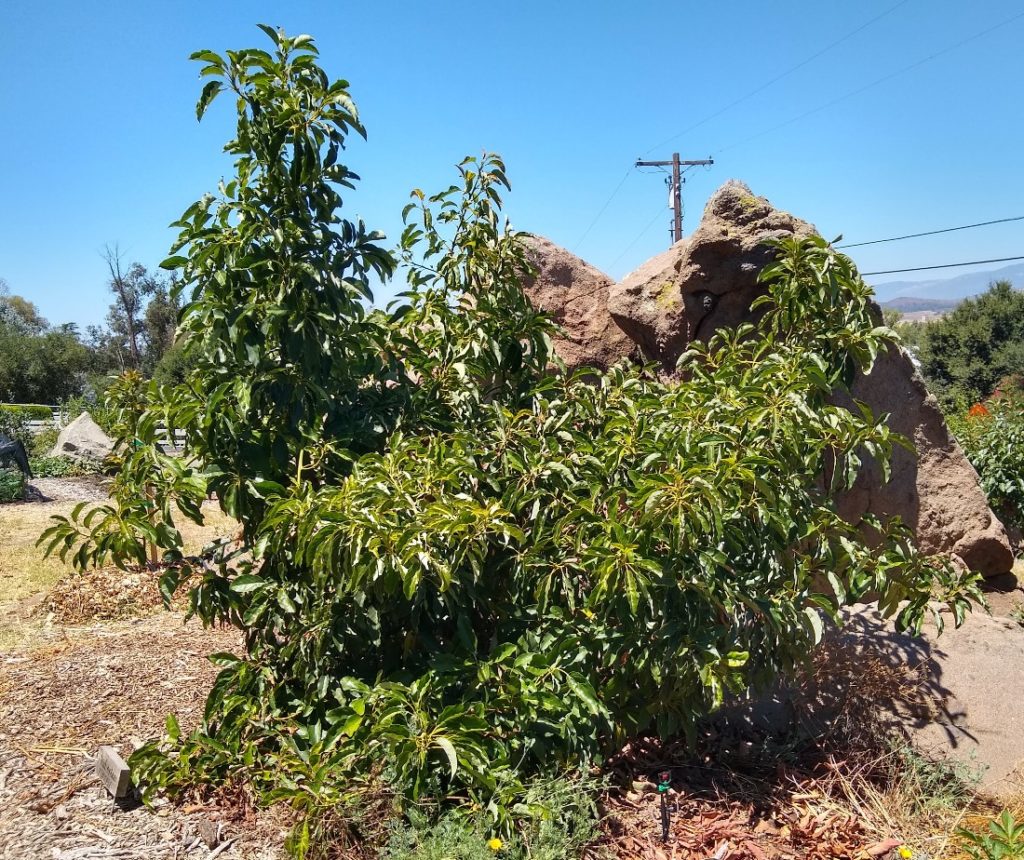
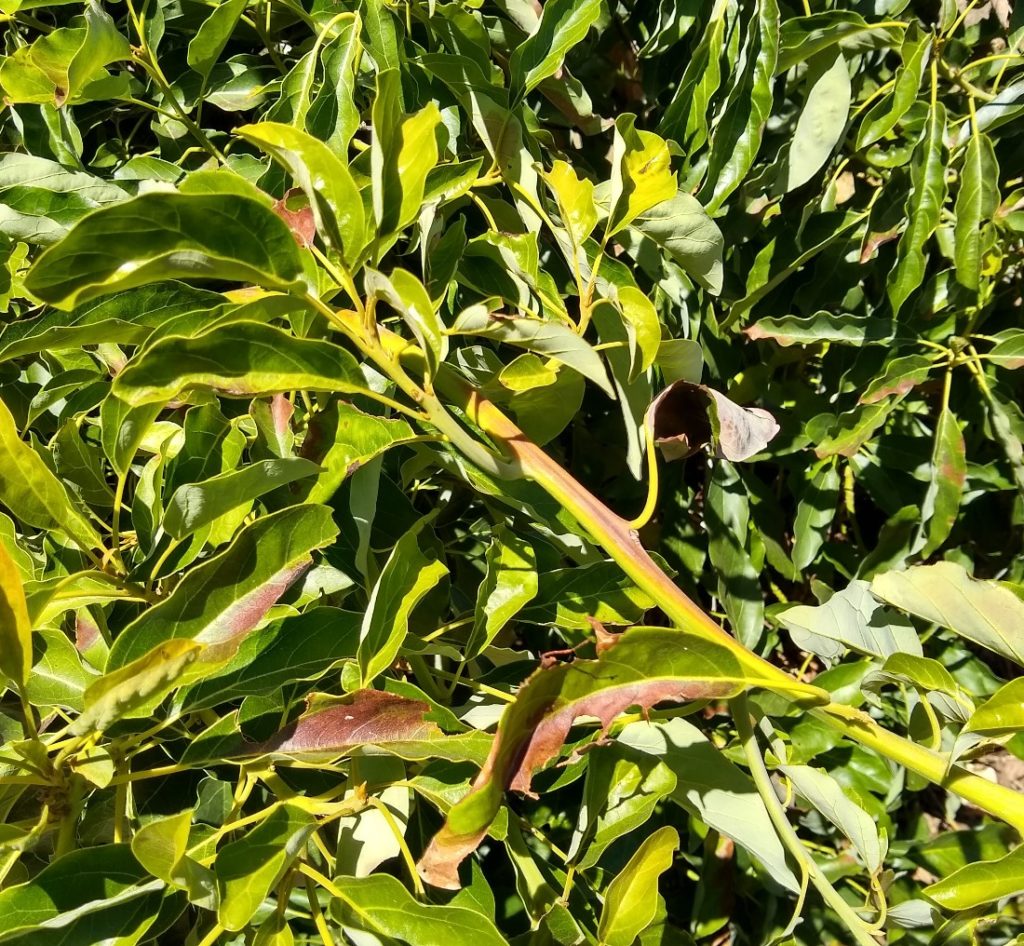
Such damage isn’t pretty but neither is it significant, in my view. (No fruit is dropping, no twigs are dying back, etc.)
Therefore, if you live in a place that never reaches over 105 degrees, don’t bother reading the rest of this post except out of pure curiosity (and perhaps pity for those of us who do deal with such heat).
However, temperatures below 105 can be dangerous to avocado trees if they hit at specific times, specifically, in the late spring (think: June). This is because some avocado varieties bloom late, and temperatures around 100 can cause these flowers to not set fruit or recently set fruitlets to drop. More about this in my notes on the Reed variety below. But remember that if you don’t get up to 105 in summer, then you almost surely don’t get up to near 100 in late spring either.
So what is “heat” for the purposes of this post? Heat is around 100 in late spring or over 105 anytime.
My yard: my observations
I’m located in Ramona, San Diego County. Over the last eight summers that I’ve been growing avocados in this location, there have been many days over 105 degrees, but there have only been two heat waves where my avocado trees had to deal with temperatures over 110 degrees. Those two events have especially revealed different responses to high heat among my different avocado varieties.
June 20, 2016
On June 20, 2016, the thermometer on my shaded front porch reached 109 degrees. It was surely a few degrees hotter out among the trees. The humidity dropped to a low of 7% during this heat.
Nevertheless, no fruit dropped. I had mature fruit on my Reed and Lamb trees. In addition, I had newly set fruit on my Reed (which was also still blooming at the time), Lamb, and Hass trees. None of this fruit dropped during or in the weeks after the high heat.
(Prior to that day, I had irrigated in anticipation of the heat. On that day, I intermittently ran the micro-sprinklers under my trees.)
Some foliage was damaged, however. The worst burn on leaves and stems was incurred by my Hass and Fuerte trees.
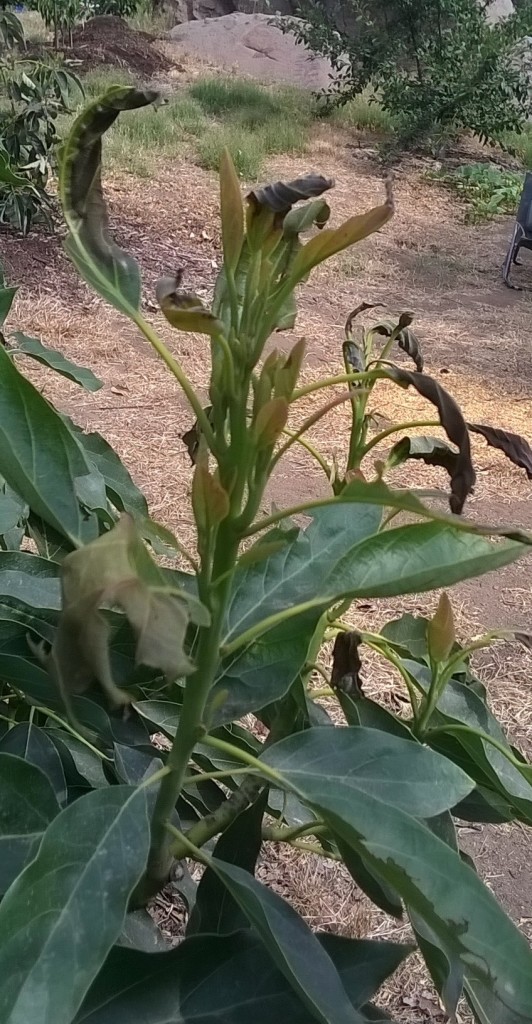
The Sir-Prize, Sharwil, and Pinkerton were somewhat less burned. And the Reed and Lamb trees appeared almost undamaged.

An important lesson from that heat event was that Reed, Lamb, and Hass can hold their young fruit through a hot spell that reaches around 110 on even the longest (and therefore potentially hottest in terms of duration) day of the year.
I wasn’t surprised that the mature fruit held on the Reed and Lamb, but it was remarkable that the tiny new fruit held since young fruit is more vulnerable to dropping because of high heat than mature fruit.
July 6 and 7, 2018
The heat of July 2018 was the highest on record for most of Southern California. Santa Ana hit 114 and Riverside hit 118. Avocado trees looked torched all over the Southland.
In my own yard, the worst burn of foliage was seen on my Pinkerton and Nimlioh trees.
Hass and Fuerte were in the middle.
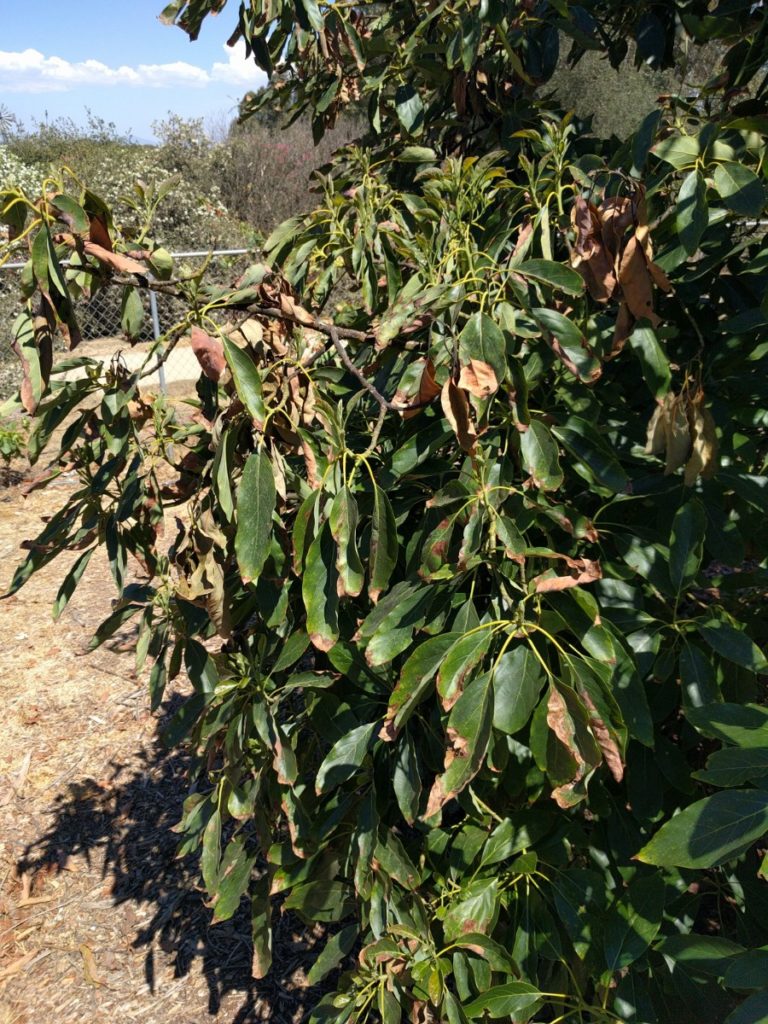
The Lamb canopy looked slightly damaged, and the Reed canopy looked least damaged.
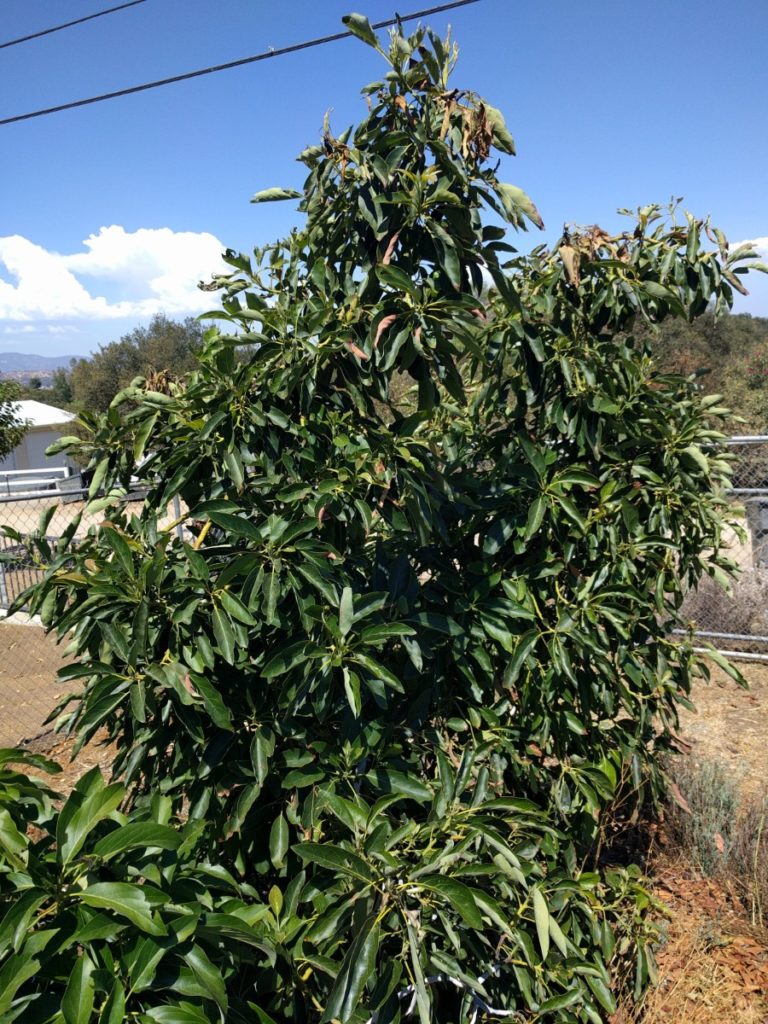
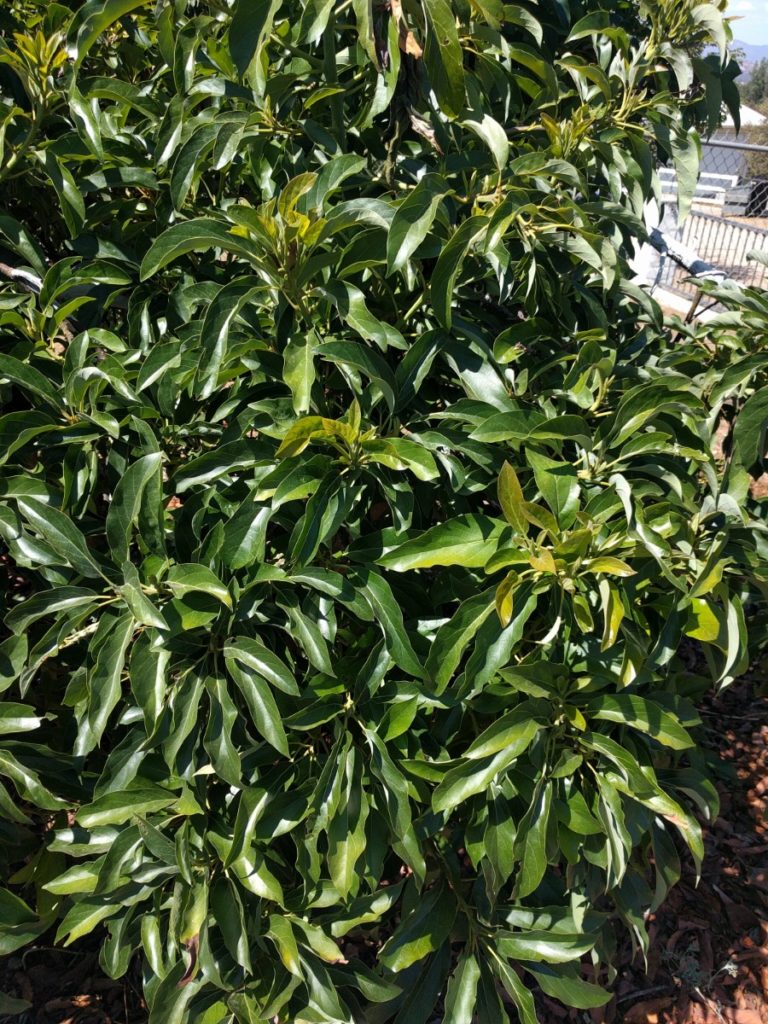
(See video of the damage on some of my trees on July 8, 2018.)
The more important damage was to fruit, not foliage. Immediately after the heat subsided, it appeared that most of the fruit held. But over the next few weeks, much fruit dropped.
(Again, I had irrigated prior to the heat. But this time it was four days before — on July 2. I then irrigated during the heat on July 6. I also pulsed micro-sprinklers intermittently throughout the heat and even hosed down canopies a few times.)
By the end of July, I could judge how each variety had held onto its fruit.
From worst to best:
The Hass dropped almost all of its young fruit. There was no mature fruit, as it had all been harvested by late June.
The Reed dropped almost all of its young fruit. But it held onto all of its mature fruit.
The Lamb dropped most of its young fruit but held onto some of it. The Lamb was in an “off” year in 2018 and was holding no mature fruit.
The Pinkerton dropped half of its young fruit. It was not carrying any mature fruit.
My other trees were too young or carrying too few fruit at the time to be worth mentioning.
One important lesson I took from this heat event was that different varieties respond to high heat in different ways. While the Pinkerton tree’s foliage looked terrible, it tenaciously held onto more of its young fruit than any other variety.

On the other hand, the Reed tree’s foliage looked relatively unfazed but then it couldn’t hold onto its young fruit.
Which is preferable: tough leaves or tough fruit? Dropped fruit is a total loss. The Reed had basically no crop to harvest in 2019. Leaves grow back, as you can see in the photo of the Pinkerton below.
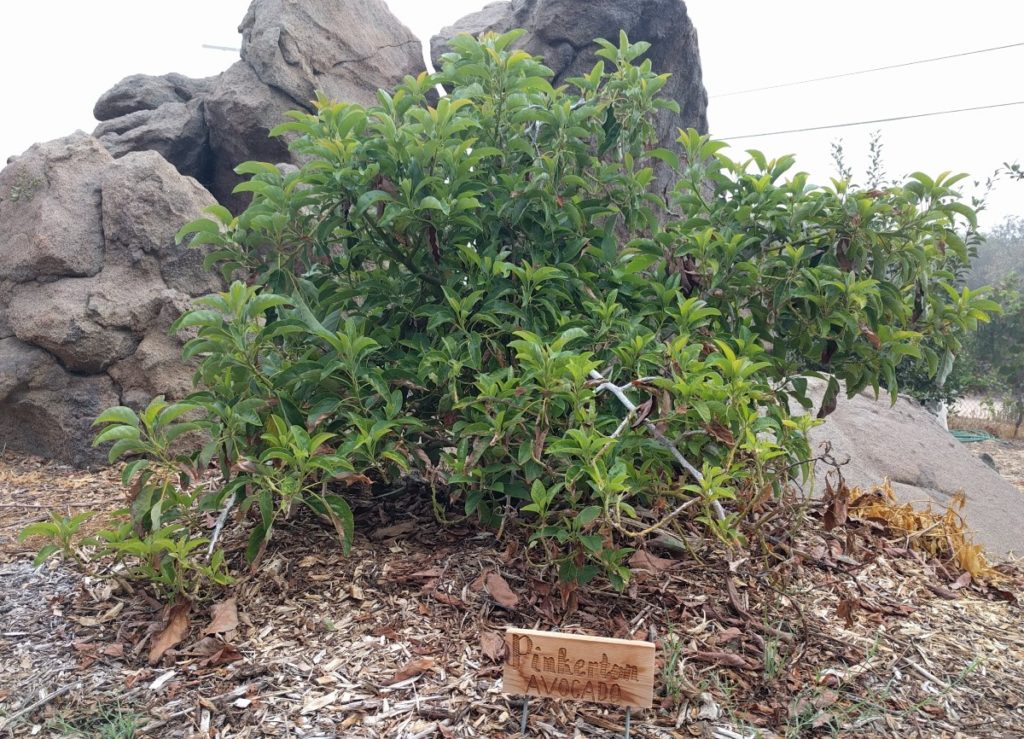
However, avocados bloom mostly on foliage that has grown during the previous summer. If much of that foliage gets damaged, then the following spring’s bloom is diminished, and that year’s fruitset is diminished.
My Pinkerton had a weak bloom in the spring of 2019 whereas my Reed had a heavy bloom in the spring of 2019 and set so much fruit that branches had to be propped for support.
To me, there isn’t a clear winner. Each tree essentially lost a year’s crop although a different year’s crop. But for my location and others with similar levels of heat (that is, not significantly higher levels of heat), I’d give the slight advantage to Reed considering that it showed that it can hold its young fruit through temps around 110 (in the 2016 event), just not through temps around 117. (Though my shaded porch registered 113, I estimate the temperature out among my trees to have been about 117 since that is what the nearest official weather station recorded.) It must be remembered that the July 2018 heat of 117 was an all-time record event, not a frequent, let alone yearly, occurrence.
Other locations: my observations
I visited other yards and avocado groves in the days, weeks, and months after that record heat of July 2018. Mostly, but not always, varieties responded the same as they did in my yard.
At a friend’s grove nearby that is larger than mine but has many of the same varieties, I noted many striking similarities:
-Pinkerton trees’ foliage terrible, the worst, even though they held their young fruit.
-Hass dropped almost all fruit and foliage looks really bad.
-Fuerte foliage almost as bad as Hass. (Fruit drop? Didn’t note.)
-Reed foliage looks good, but dropped all young fruit.
-Lamb looks pretty good and is holding some young fruit.
-Holiday foliage is OK and is holding some young fruit.
-Bacon foliage is OK, holding much young fruit.
-Stewart same as Bacon.
-Ardith foliage excellent, maybe best of all, but hadn’t bloomed that spring.
Down the road from my house there are commercial groves of Hass avocados. Strangely, some groves had trees that looked similar to mine after the July 2018 heat.
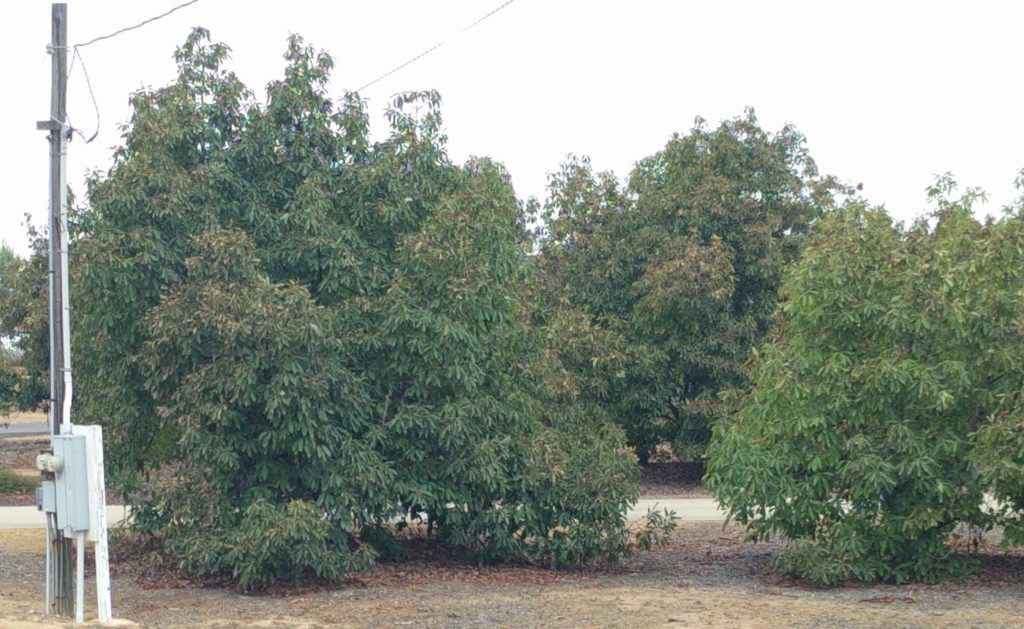
Yet, other groves of Hass had trees that looked half dead.
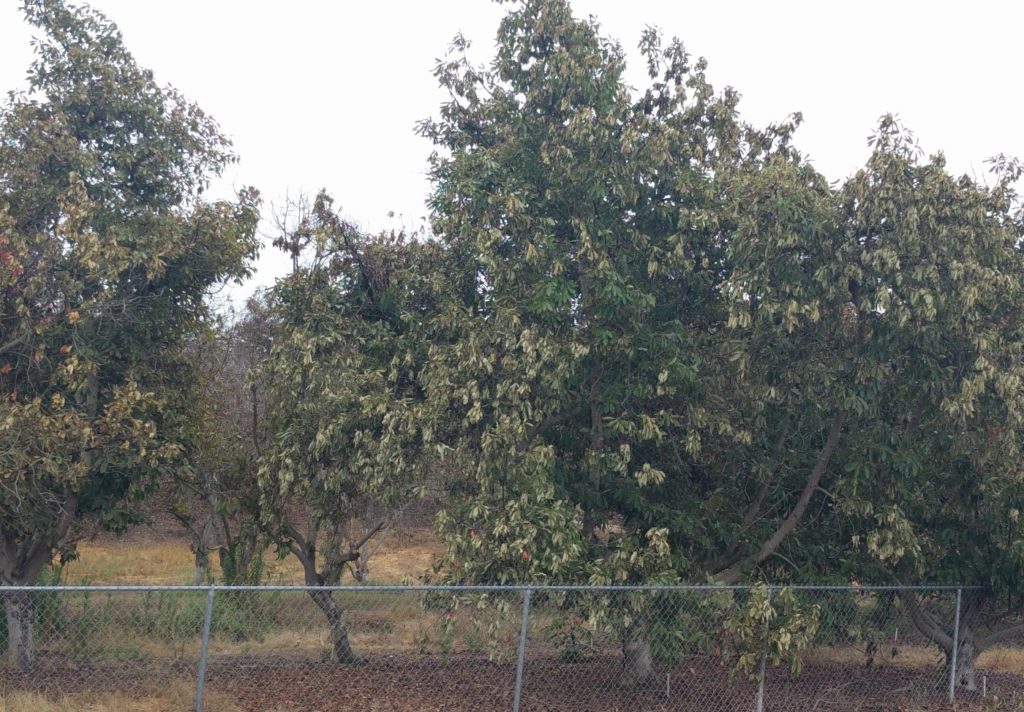
Later, on July 23, I drove through the Santa Clara Valley in Ventura County (Route 126) and I noticed similar contrasts. All of the groves appeared to be Hass, if my eyes served me well, but some groups of trees looked hardly harmed while others right next door looked set on fire.
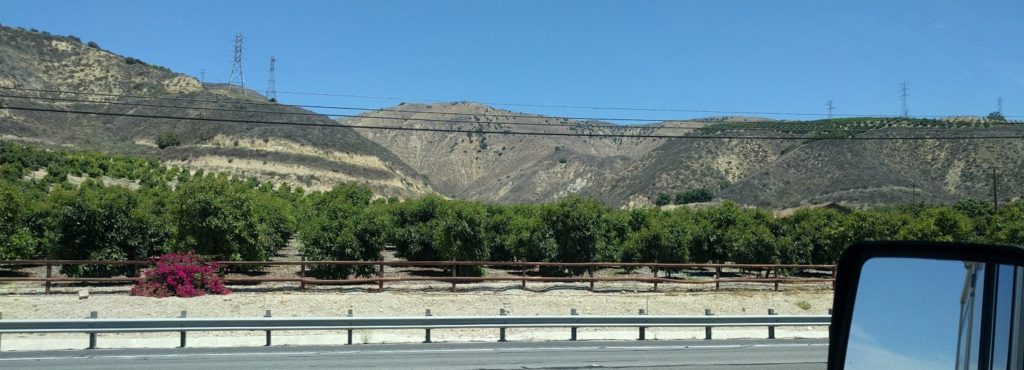
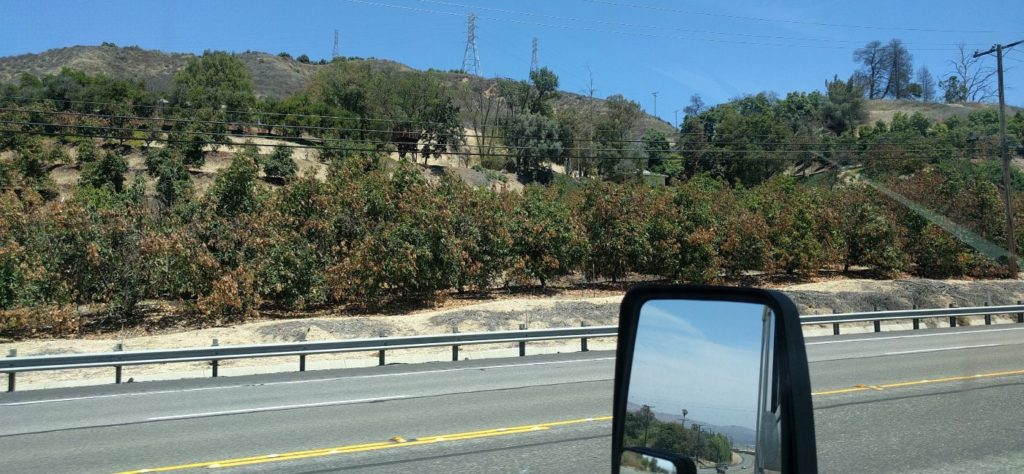
Difficulties in assessing relative heat tolerance of avocado varieties
So we have the same variety, Hass, experiencing similar heat, but with a spectrum of responses. Explain that. (And if you can’t, then how can you validly compare different varieties?)
There are many contributing factors to a particular avocado tree’s (or entire grove of trees’) response to heat. First, there’s the overall care of the tree and health of the tree. Water, soil fertility, soil salinity, diseases, pests, etc. Some of these factors are invisible (e.g. soil salinity), and some are probably unknown (e.g. competition from roots of nearby oak trees).
Second, what about rootstock? These trees may have the same scion variety on top but many have different types of rootstock underneath. This is particularly relevant to backyard growers, whose trees are usually on seedling rootstocks and are therefore variable. But even avocado farms had trees on seedling rootstocks back in 1917 when a severe heat wave hit Southern California. Thomas Shedden of Monrovia made this observation of his grove then: “In rows of same variety, age, planting and care, here and there trees stood the burning heat remarkably well, while the next several would have to be heavily trimmed, or cut back to stumps.” Was this rootstock influence?
These days, many avocado groves have trees on clonal rootstocks so there is little to no variation of that factor. And it has been documented that the same scion variety performed differently on different clonal rootstocks during that July 2018 heat. You can see some unpublished data from a trial of 30 rootstocks on Hass scions in Santa Paula, Ventura County at about 1:40 in this video. Also see 1:48 for heat damage results from another similar trial in Temecula. These are University of California trials.
Third, all varieties are on different phenological schedules. In other words, they are growing new leaves and blooming at slightly different times. This is critical because younger leaves are more susceptible to heat, as are younger fruit. Reed blooms late so if there’s an early heat wave, such as in late June or early July, the Reed fruitlets are very small compared to the size/maturity of fruitlets of all other varieties, making Reed fruitlets more vulnerable to the heat. So the mere timing of a heat wave can affect different varieties differently, making comparisons between varieties challenging.
Other locations: others’ observations
In the Summer 2020 issue of the Avocado Quarterly, a publication of the California Avocado Society, Sonia Rios, a farm advisor with the University of California Cooperative Extension, wrote an article titled “Beat the Heat” where she said that the most sensitive varieties to heat are “Hass and Fuerte, whose new leaves shrivel like plastic held to fire. Less affected are the varieties Sir-Prize and Sharwil, which show blackening and curling on some new leaves. Some of the toughest are the Pinkerton, Lamb Hass, and Reed. They show nearly zero evidence of having been uncomfortable under a terribly strong sun.”
Rios doesn’t detail where or when she observed this, and it sounds like she’s only commenting on the heat tolerance of the varieties’ foliage (not fruit), but it’s interesting to note all the same.
Mary Lu Arpaia, also of the University of California, has made comments on the heat tolerance and heat responses of certain avocado varieties. Arpaia has observed that GEM is more “heat hardy” than Hass, and that GEM fruit grown in the hot Central Valley keeps its size a bit better than Hass but sometimes has a more elongated shape than when grown in cooler locations down south and along the coast.
Arpaia has also said that Lamb is more heat tolerant than Hass. Unfortunately, I haven’t heard her elaborate on how she has seen Lamb reveal better heat tolerance than Hass — tougher foliage, fruit, both, other?
One of the few commercial avocado growers in the Central Valley, located near Exeter, who mainly grows Hass and Lamb, once told me that his Hass avocados tend to be smaller than those grown in cooler locations. (See examples of avocados grown in the Central Valley compared to a cooler location in Orange County at 52 minutes in this video.)
This farmer also mentioned that he isn’t so happy with his Lamb trees because of their habit of dropping fruit as soon as it is barely mature in about May. Hass doesn’t have this early-drop habit for him. (This is possibly related to the fact that Hass is harvested before May, before heat arrives, and it’s possible that heat exaggerates the early-drop habit of Lamb.)
Eric Focht, a researcher for the University of California, has said that a variety called Harvest did particularly well in the heat of the Coachella Valley, where the University did some trial plantings. But Focht noted that this observation was anecdotal; no formal study on heat tolerance has been done.
An important side note is that heat tolerance does not necessarily come together with tolerance to the other end of the temperature spectrum: cold. Harvest performed worst in a cold spell at a University of California planting in the Central Valley. This is important to keep in mind because often locations that are extreme on the hot end are also extreme on the cold end. Tough trees in the heat aren’t necessarily tough all around.
Conclusions
Where does all this leave us? General conclusions:
-No formal study of heat tolerance of avocado varieties exists to my knowledge;
-All we have are anecdotal observations;
-These anecdotal observations sometimes conflict, which is not surprising because . . .
-One, claims about heat tolerance are sometimes not well defined (toughness of foliage or fruit holding capacity or what?);
-And two, we’re not always comparing apples to apples (different rootstocks, size and ages of trees, timing of heat in relation to the different varieties’ phenological schedules, irrigation and other care for the trees)
Tentative suggestion
I’d love to be able to land on a short list of avocado varieties that have been shown to be superior in heat overall. Inversely, I’d love to be able to list some varieties that tank in the heat and shouldn’t be bothered with in certain locations. But what I’m actually left with is the feeling that there’s a lot left to learn about the heat tolerance of avocado varieties, and every variety that I know that is worth growing in other respects is worth trying in a location with heat.
I suggest this because of the results I’ve seen in my yard along with all of the other evidence gathered and discussed above. And one final piece of the puzzle that informs this is the visit I made to a grove in Redlands in February of 2019. (I mentioned this visit in my post about protecting avocado trees from heat.) On that day I observed excellent crop loads of mature or nearly mature fruit on trees of the following varieties: Hass, Fuerte, Carmen, Bacon, and Pinkerton.
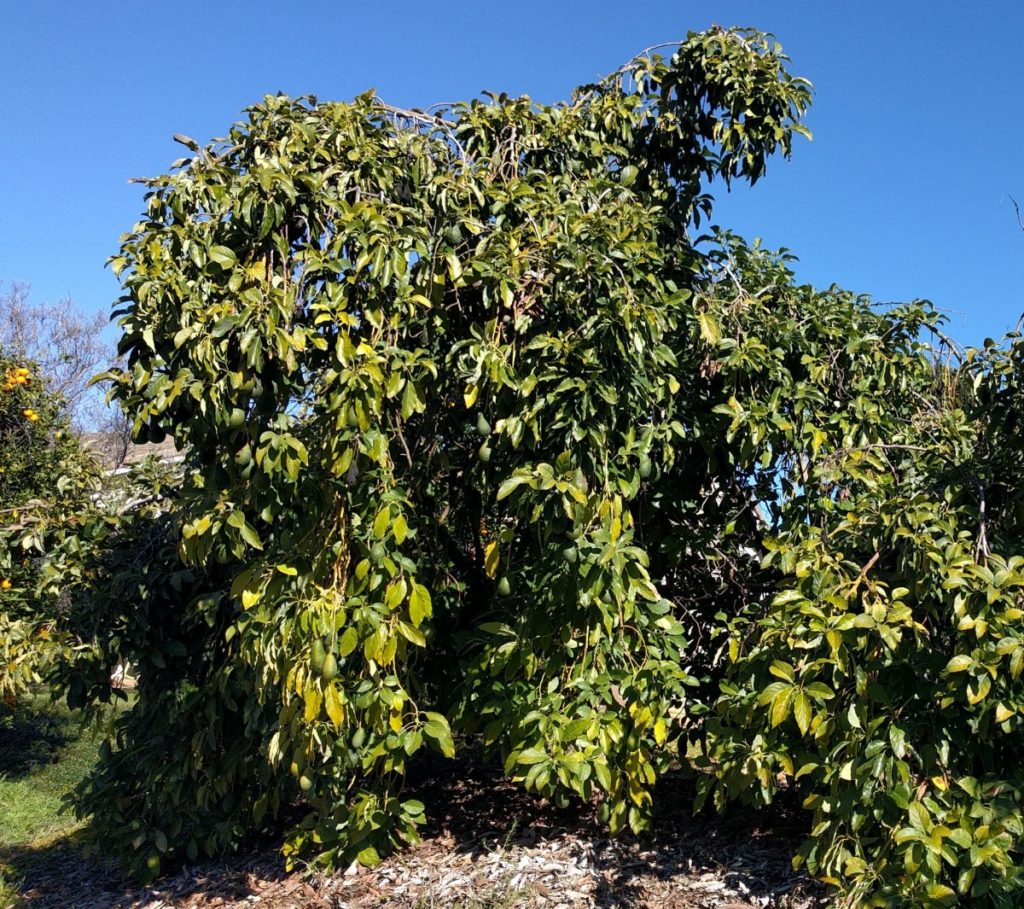
The Pinkerton and Bacon I wasn’t too surprised about. But especially the Hass and Fuerte crops were curious. These avocados would have been small fruitlets during the extreme heat of July 6 and 7, 2018. I don’t know the high temperatures that this grove reached on those days, but I know that the general area is usually as hot or even hotter than nearby Riverside where it hit 118.
These Hass and Fuerte trees carried young fruit through a couple days of heat around 118 degrees. I know of many other Fuerte trees in the area that dropped all or much of their young fruit in July 2018. I know of many Hass trees that did the same, of course. Moreover, the Hass trees that held their young fruit in the Redlands grove were young and old alike, from two years in the ground to more than two decades in the ground.
I’m reminded of something a Chilean avocado farmer told me when I asked him about his opinion of the difference in heat tolerance between the varieties he grows: Hass and Reed. He said, “It’s not about the variety; it’s about the management.”
I don’t know if he’s all right, but I suspect he’s at least partly right. So why not try any avocado variety anywhere?
Note: I published a thin, first version of this post in 2016. And I’ve left all of the comments from that original post below.
All of my other Yard Posts are HERE

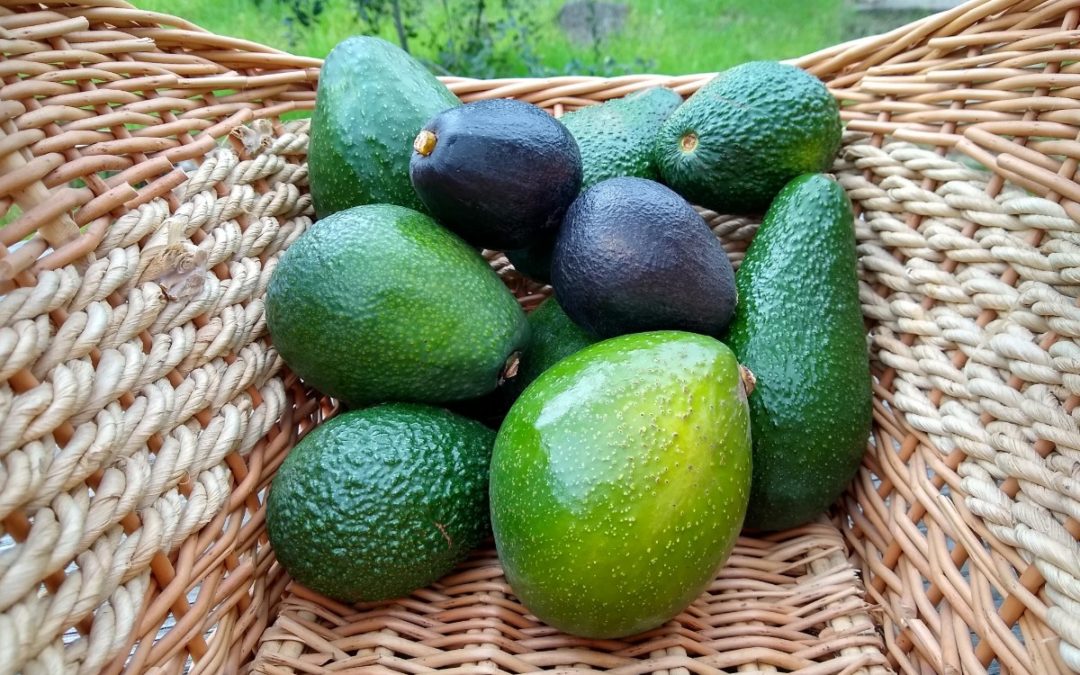


do you know how the Gem avocado does in heat. I am in Fresno CA. and was researching avocado varieties. is there one you would recommend for heat tolerant.
Hi Grant,
At this time, I don’t know how GEM does in high heat, sorry. And I can’t find anyone else who does.
In my experience, as well as others in places with hot summers, Reed is one to recommend. It not only takes the heat very well, but also produces and tastes great.
Unfortunately, Reed doesn’t have better cold tolerance than most avocado varieties. Yet, my Reed readily grows back from minor cold damage almost every year.
GEM fared about as well as Hass in the 2016 toasting. Dropped all its fruit, as did Hass, and had some leaf burning. The heat killed a small Marvel (a good pollinator variety still in testing) that was going great guns all winter. I even had a cotton dishtowel shading it.
Hi Randall,
Thanks for these contributions. I did once hear Mary Lu Arpaia mention GEM as having a bit better heat tolerance than Hass, but she didn’t give details. I’ve seen no such differences as yet in my yard. Sounds like the difference is likely small, if there. Maybe we’ll get some more experience to draw from this summer; it’s finally heating up here.
A Hass actually had less leaf burn but did drop its fruit. A big old Fuerte didn’t seem to care! My yard is in Irvine so those temperatures were abnormally high. I keep wondering if I could have saved the Marvel by spraying the leaves with water.
Randall – About that small dead Marvel, I haven’t been able to grow any variety of avocado here in Sylmar without shade cloth the first few summers. Doesn’t matter whether it’s in a number 5 or 15 pot, they all seem to need shade or they die.
p.s. Tell me more about Marvels
The Marvel had a shade cloth but still got too hot. I wish I had been around to spray cool water on it. The Marvel is still in development. A tasty fruit I’m told and an excellent pollinator. Was growing like a weed before two hot days.
What would be your top choices for backyard planting? we’re in fountain valley close to Irvine.
Hass would be a good choice and widely available. Plant atop as high a mound of soil as you can, put some gypsum in the hole, and mulch with a thick layer of pine bark chunks. Don’t overwater! A cheap soil moisture probe like the Dr.Meter S10 Soil Moisture Sensor Meter (no affiliation) on Amazon really helps. Avocados pretend to need water by wilting. Don’t believe them! 🙂
When will Marvel be available Sounds like its a good variety. Also ever hear of Gordo avocado? any inside on this variety?
Hi Moses,
A couple weeks ago I was told by someone in the UC breeding program that Marvel will hopefully be released soon, but they can’t give any dates. They’re not in control. The University of California has entered a new agreement with a Spanish company called Eurosemillas to market their new avocado varieties. See this article: https://news.ucr.edu/articles/2020/06/09/uc-riverside-and-eurosemillas-partner-bring-next-generation-avocados-market
I wouldn’t hold my breath. Marvel has been said to be on the verge of release for years. And when it is released, it’s almost certain that large commercial growers will receive all of the early stock.
I don’t know anything about a Gordo avocado variety beyond its entry in this database: http://www.avocadosource.com/AvocadoVarieties/QueryDB.asp
There it doesn’t sound promising, as it is said about the Gordo: “After 6 years of testing we are finding these to have poor flavor.”
Greg – I was visiting Green Thumb in Canoga Park and they had three Ettingers in #5 pots and asked about them. Here is what I was told “They were developed in Israel, lots of fruit, and could stand up to higher temp’s.” I went home and did some Google research.
1) Page 1 California Avocado Society 1965 Yearbook 49:55-60 Mean Max
temperatures in the summer months are 12 – 14 degrees F higher in Israel than
San Diego.
2) They are an early crop.
3) Fruit is like a mild Fuerte. Tastes “Good” not “Excellent”.
4) Has a big seed.
5) Apparently has a short season in Israel.
6) They shipped a lot and the orchards were “a profitable variety”.
The guys are the same guys that developed drip systems. If they developed an avocado that doesn’t taste “excellent”, has a big seed and a short harvest season
something is going on and it’s got to be heat resistance. I figure “what the heck – give it a try” and I went back yesterday and spent $39.95.
p.s. I should have called Ventura and asked if they had one in 15 Gallons.
Hi Dal,
Glad you bought that Ettinger tree. I look forward to hearing how it does in your location.
I have eaten a few, and I liked them. Good but not excellent, seems an accurate way to put it. Here is what Bob Bergh once said of Ettinger: “It is comparable to California’s Bacon and Zutano, but with superior flavor and general quality.”
I’m going to have to ask around about Ettinger’s heat tolerance. Few people grow it here in California. I don’t have an Ettinger — as of now; I think you’ve persuaded me to add one.
U.C.’s Master Gardener Book says Duke has high wind and heat resistance.
Hi Dal,
That seems plausible considering the Duke is said to have originated and grown well in Bangor, up in Butte County, in Northern California. It apparently also shows good cold tolerance. Here’s a nice history of the Duke avocado variety: http://www.avocadosource.com/CAS_Yearbooks/CAS_47_1963/CAS_1963_PG_28-36.pdf
Ettimger is not very heat tolerant near CSUN. I have lost (2) despite providing anticipatory
protection from heat.
Aside from the heat issue (which I rarely have in Northern CA and never to your extremes), how do you like your Sir Prize? A rancher brings them to my Farmers Market, and I adore those little single serving sized gems, plus they keep for months in the fridge and don’t turn brown. How would it do in the San Mateo area, and what should I expect size- (and other-) wise of the tree?
Hi Susan,
I actually cut my Sir-Prize way back earlier this year. The fruit is very tasty but it just doesn’t bear enough to earn its spot in the yard. I would guess it would grow fine in San Mateo but I can’t say for sure. As to whether it will bear much fruit for you, I’ve never known anyone with a Sir-Prize who says they are highly productive. Of the trees I know, they seem to grow more on the erect side.
Hi there! I have a Reed avocado that i found sprouted in my compost barrel. It’s done famously well in a pot, and i put it in our green house in the winter (i live in theSan Bernardino Mountains.)
Alas, it’s getting to tall for the greenhouse. We just purchased another home in Desert Hot Springs, and i was thinking of transplanting it there. Do you think it would survive, with adequate water and judicious shade?
Hi RuthAnn,
Yes, I do think you could get it to survive outside there. I’ve read of avocados growing in the shade of date palms in the Coachella Valley. Ideal would be to get it planted early this fall so it settles in all winter and spring before it has to deal with the tough summer heat.
Greg, I live in bakersfield ca. I am looking to plant a Gem do to smaller tree and I am told it to high producer with taste better than hass. Your comments Please.
Jim Schaeffer
Hi Jim,
GEM sounds like a good variety for you. Yes, it is a smaller tree compared to some others, such as Hass. And it also produces a bit more than Hass.
Everyone I know says GEM tastes good, but I don’t know about better than Hass. I think both taste great. It can be hard to compare directly since the GEM season is a little later than Hass.
Most promising for you in Bakersfield is that GEM seems to be more cold and heat tolerant than Hass, this according to Mary Lu Arpaia who is testing them there in the Central Valley.
Here is a slide presentation about GEM from Brokaw Nursery, who has a lot of experience growing the variety: https://brokawnursery.files.wordpress.com/2017/12/gem-presentation-consuelo-2.pdf
In my experience with avocado varieties, Reed is the most heat tolerant of the common varieties. As far as frost, Reed seems to flower later than my other varieties.and this is protective against frost and setting fruit. The dense foliage of Reed seems to help shade the tender shoots. Stewart, the one from Laverne Nursery, seems to be very heat tolerant also. Probably the next most heat tolerant for me in Sunset zone 19 are Lamb and Pinkerton. Hass and especially Fuerte seem to be heat sensitive. Fuerte though to me has the best taste.
Thanks for this, Richard. My observations have been the same. One detail I would add is about Pinkerton.
My Pinkerton, as well as all of the other Pinkertons I’ve seen growing in hot, inland locations like mine, gets some sunburn on its leaves and branches. So in that sense it is not great in the heat. On the contrary, the Pinkerton fruit is tough. It’s not so easily sunburned and the young fruit holds even through severe hot spells. The end result is that the Pinkerton tree carries a good crop through to harvest but doesn’t look so healthy through it all. Strange contradiction in qualities, that variety. Is your Pinkerton like this?
Hi Greg,
I think Pinkerton is underplanted. It is very productive, precocious, tastes great, and in many of my Pinkerton trees, they seem to sprawl over the ground. It was my only tree that had produced any fruit. I probably should give you a little background though. I have several varieties such as Julia, Nabal, holiday, Stewart from durling and from Laverne (totally different growth patterns and the leaves are usually different in color and shape), fuerte, holiday, Mexicola, Mexicola grande, bacon, and some others .Most of my predominately Mexican varieties, with the exception of a couple of large Laverne Stewart’s, got scorched last year, if I remember correctly, it was over 115. We had a double whammy last year, a mild winter then a late sudden frost, a mild spring/summer and then the scorcher. As a whole, the Guatemalans, foliage-wise, did better. My irrigation system does need some work though, the trees are on drip and i’m In the process of changing over to microsprinklers. Of the trees that are not shaded at all, Reed and Nabal definitely performed much better in the heat, once they get some size. Looking at my trees, most of my Pinkerton are shaded on their western side. .I planted the Guatemalans on a slope while my Mexican varieties are in poor air drainage areas. Right now the trees look healthy and are carrying a fair amount of fruit.
Hi Greg, I live in Tucson,Arizona. I was gifted a Bacon avocado tree in November of 2017. It seems to be doing okay. I do notice that the tips of my older leaves do turn brown. I thought that it was our extreme heat of between 112-115 and the normal is usually 104-107. How should I care for it especially during our summer months? I planted it in a 30 gallon trash can and I drilled holes in the bottom for drainage. I’ve set it up on rollers so that I can move it out of the direct heat and the wind(April through May) also from the frost.
Hi Pat,
It sounds like you are doing everything necessary. I’ve never grown an avocado in such conditions, but I do know that when we get heat waves where it is over 100 for days at a time, the most helpful thing I can do is keep the tree watered. This can mean watering multiple times per day.
We live in Palm Desert/Indio California where it gets to 118. I read about the Aravaipa Avocado from Arizona which are apparently scarce. Your thoughts?
Hi Greg,
I only know what I’ve read about Aravaipa, which includes that it doesn’t have a good reputation for taste. Sorry I can’t give more information on this variety.
I can’t speak for the taste of the Aravaipa (no fruit yet) but mine has handled the heat well. I’m in Temecula CA and hit 115 last summer during that heat wave. My 2 year old Aravaipa was in full sun and unprotected and had no damage. My 3 year old Wurtz took some serious heat damage and it only gets direct sun in the morning. Completely shaded by noon. Seems to have recovered well though.
Thanks for this, Ken. I love hearing firsthand observations like yours.
Greg – A follow up on my Stewart.
It’s a small tree, but I love the fruit. Right now (21 Dec.) in Sylmar the fruit is at the end of it’s season and I think it has been a good season.
I think if your neighbor’s fruit is dropping and the birds are eating it, they are waiting too long to pick. When the fruit gets real black or those little cracks appear around the neck, it’s time to pick. Near the end of the season you can go out every morning and pick up any that have fallen on the ground. I also give a slight pull to the hanging fruit and see it they come off easy. I let the tree leaves hit the ground so I don’t have any bird problems, but then you might get mice problems.
If you have rodent problems I recommend putting out some mice or rat poison (or traps) prior to the harvest season.
I have a 30 year old Wertz ,a.k.a.”Littlecado” planted on the side of my house in Sylmar, CA. That heat wave last summer caused a lot of leaf damage but the worst thing was I lost 50 to 75 good sized avocados that just dropped to the ground. I didn’t irrigate before the heat wave so that may have contributed to the disaster. My Bacon also doesn’t seem to like heat and a Sunset article around 1987 confirmed this so I’m thinking about grafting it into something more tolerant to heat waves.
My Steward seems to take some of this high heat and has a lot of avocados this year.
If the earth is warming, I think U.C. needs to do some research on which Avocado trees stand up to heat
Thank you so much for these contributions, Dal. I didn’t have Wertz or Bacon or Stewart growing through that July 2018 heat.
Can I ask whether your Stewart fruit hang long enough for you to be satisfied with the harvest? A nearby friend growing Stewart gets disappointed each fall when they’re mature and they start dropping to the ground and birds peck through their thin skin — not to mention that the skin often cracks near the stem end. His Stewart avocados taste great, but these other characteristics of the tree and fruit irritate him.
As far as I know, University of California researchers aren’t doing anything directly on heat tolerance right now, but they have picked up some incidental information over the years. For one thing, they observed and recorded how all of their avocado trees being used in trials for other things like rootstocks fared during that July 2018 heat event. They also in the past trialed varieties in the Coachella Valley, and they have been growing them up in the heat of the Central Valley for a long time. I have talked to one U.C. researcher about this heat-tolerance topic and he is fully aware that more studies on it would be useful.
I’m going to write an updated version of this heat-tolerance post as soon as I get the time because I do have some further information that I’ve gathered from my own trees and other anecdotal reports, including the U.C. stuff. It’s all anecdotal and not rigorous scientific research, but it’s better than nothing.
Greg – I planted that slow growing Stewart about 10 years ago after my heart attack and my doctor said I should eat avocados. Never got any fruit until three years ago when I planted a 5 gal Gwen next to it. Last year and this year I sprayed the blossom’s with a honey & water mix. I don’t know if it was the Gwen or the honey but I’ve got AVOCADOS. I’ve never pruned the tree and the fruit is hidden inside a good canopy, so no bird problems. No fruit drop either. and the fruit is just starting to mature ( 2 weeks later than a neighbors Mexicola). I’ll keep in touch if things change.
How does a mexicola grande do in high heat .I know it does well in cold weather. We live in the hills above Corona Calif.
Hi Steve,
I don’t know for sure. I don’t grow Mexicola Grande in my yard nor do I know anyone growing it in a hot place. Sorry about that. I’ll update you if I find anything out there.
But you do have lots of other great avocado variety options in and around Corona. In fact, there’s no variety that I can think of that won’t grow well there.
Steve- I have a neighbor a few blocks away here in Sylmar that has a Mexicola in their backyard. The tree and fruit seem to hold up well to these heat spells. Not a big crop, but that might be due to water or fertilizer management problems.
Also it’s amazing how many of my neighbors in Sylmar abuse their avocado trees by raking up the leaves.
Great subject and posts! Greenhouse grower here in central Texas, big greenhouse with a 18′ ridge. All trees are on steroids – Sharwil, GEM, Lamb Hass, Reed, Ardith, Oro Negro, Pinkerton. Here’s some of the text I posted just now at the Tropical Fruit Forum to a Yuba City Cali grower who lost his avocados. “We have heat, lots of it. In fact we had a very weak “cold” front move thru yesterday afternoon and when I checked on the greenhouse it was 110F. I didn’t have my fans going. It’s hit 112F this summer and most daily temps were 100F + especially in July. Trees are fine.
Are you giving them enough water in respect to your sandy soil structure and how is the water quality? My citrus really started looking stressed out until I really upped up my watering. However, our water quality is the pits with bicarbs of Ca and Mg thru the roof. TDS is like 800 ppm at times. Rains stopped (we’re in a drought now) so I had to resort to well water rather than rain as I ran out of the latter. Surprisingly they are fine. FWIW, most of my trees are on Florida pits which have W. Indies genes in them, those big fat watery greenies. I’ve tried a lot of rootstocks but nothing is a better match for our well water or imparts more vigor than Florida pits seedlings.
My Reed can take all the heat you throw at it. Here’s a list of avocado varieties that take heat well during a SoCal heatwave.
https://gregalder.com/yardposts/heat-tolerance-of-avocado-varieties/“
CORRECTED:
I live in Tucson Arizona, very hot and arid/dry place. Our humidity is 5-9% many days. Now, you’re in So Calif where on average humidity in So Cal is around 60%, in comparison our air in Tucson is lacking moisture which compounds problems of hydration more than in Corona Calif, but still the temps are a little similar.
Corona Calif, I have lived in that area. It is hot and dry but not as bad as Tucson. For Corona CA I would use the similar regiment I do here in Tucson.
As for cold, my Mexicola withstood freezes and at least 2 weeks of frost we even had a tiny bit of snow a few days and I didn’t even cover it and he flowered in March. He hates being over watered so I only watered him once a week. He’s like a citrus tree, likes drying out a few days before watering and not like his feet to be standing in water.
TUCSON:
MORNING SUN TIL 12PM (but for Corona could be til 2pm)
After 2pm NO SUN – possibly use 80% shade cloth after 2pm but just plain shade is even better.
Water with RO or distilled water at least 1 week per month to keep salt and chlorine from building up.
About 2-3 gal per 3’x3′ cubic feet if in ground (every 2 days)
if in 20 gal pot about 1.5 gal (every 2 days)
My 3 yr Mexicola is in a 22 gal pot kept on the North side of my house which is my front yard. He gets all the morning sun up to 12 noon; then that side of the house is naturally shaded after 12pm. When 4pm comes around a little sun sneaks through from the west as the sun makes its way to travel to set, but I have other plants on each side of it and a shade cloth curtain to block the blistering sun sneaking through.
SUN: UNDER 100F from morning to 12pm
SHADE after 12pm to the rest of the day (For Corona that could be up til 2pm)
This works for me and we have temps here in Tucson on average during summer of 106 to 111F for all of June, July, Aug, part of Sept.
My friend in Phoenix (Phoenix is 5-7 degrees hotter than Tucson on average) he used 80% shade cloth and temps of 112-118F in summer and his tree died. He didn’t have his tree like mine where there was only morning sun, his was out in his yard. But still his Mexicola died under 112-118F in Phoenix. So the Mexicola is not up to baking in an inferno. Must have morning sun and no sun in afternoon – IF you are in Tucson or Phoenix.
Keep in mind temps are given in the shade, so when I say 118F that is IN THE SHADE, so in the sun it is much hotter.
The other thing is I water it with DISTILLED WATER because our water is so chlorinated and salted that the tips turn brown and because it is so dry and hot here. I suppose I could do 2 weeks reg hose water, then 2 weeks distilled, which is probably what I will end up doing to save time making distilled water. Now its leaves are shiny green and no more brown tips. I give him 1.5 gal distilled water every other day and avocado food sparingly 4x per year. Reg water gives too much minerals and if you also give it avocado food on top of it’s overkill then the leaves turn brown, distilled gives no minerals so you feed it avocado food which is the right balance it needs.
Monique
What about Winter Mexican, they are supposed to handle heat and cold. Anyone has any experience with them. I also live in Tucson, tried the Mexicola Grande, it got fried in the heat, even though I had 70% shade cloth it was planted in the ground. I used a suphur based compound to reduce the alkalinity of the water, it’s on drip.
Any thoughts on what I can plant in the ground here ?
What about Carmen Hass, Malama, Green Gold and Oro Negro Avocados ????
Hi Florencio,
I don’t grow Oro Negro. My Malama and Green Gold trees are too small to make meaningful conclusions about their heat tolerance. Carmen handles the heat about as well as Hass as far as my observations go at this point.
I want to plant at the area where the temperature ranges is 20DegC to 32 DegC.
It’s a mountain slope area is kindly advice what kind of Avocado should i plant as business farm. I can get Hass and Pinkerton. I live in Myanmar,South East Asia.
Thanks for your advice in advance.
Hi Steven,
I’m not able to give good advice on which varieties might do well in your location, but a couple years ago there was a group from Myanmar attending the annual meeting of the California Avocado Society so maybe you can contact some of those local growers and see which varieties are working for them.
Regarding the areas that looked totally burned right across the street from areas that were hardly affected in 2018, I would like to offer another variable: wind. I live in a subdivision that for whatever reason focuses wind so it travels across all the backyards and seems to pick up speed. I remember that not only was it hellishly hot that July but the wind in my little corner of the world was gusting up to 40mph and attacking my Hass tree like a blow torch. Lost my 1st crop and most of the leaves. If something like this is threatened again I’m putting up some sort of a wind break.
Good addition, Chris. I had forgotten about the wind that accompanied those July days. It was also windy in my yard, but I imagine it was a lot windier in some other spots, and that’s definitely an extra stress on the trees. High temperature plus low humidity plus wind, what a devastating combination.
Hi Greg, I lost a young Reed avocado tree that was planted in June 2018, partly my gardner’s inexperience in planting avocado trees, and partly the terrible heat in July. So I am going to try again, and have the nursery plant it. I have two questions, the first is, when is the best season to plant the Reed? And secondly, with it’s thin skin, if I don’t want to eat it right out of the cut half, how do I peel it? Would a potato peeler work, or just scoop it out?
Forgot to mention I live in Sierra Madre up against the mountains.
Hi Mary,
You’re probably safe to plant a Reed any day of the year. My grandmother lives right up against the same San Gabriel Mountains east of you in Glendora, and I planted a Reed in her yard about a month ago. I doubt you get frost often if you’re off the valley floor there. But if you do, then I’d plan to protect the little tree during cold spells during its first winter. And if you plant here in summer, just be sure to water amply until the weather cools in late fall.
Reed’s don’t peel well. I always scoop mine with a spoon. But if you want to try to peel it, slice the avocado half into narrow crescents and you’ll have the best luck with peeling them. I make narrow slices like that for my kids and they peel the flesh off the skin pretty easily.
Greg
I live in Tucson, where it can get hot, 110 – 112 worst case but it also goes down to 25 in winter. I have been told Winter Mexican do well in that range, any thoughts or suggestions of other Avocado trees that may do well here ?
Hi Ari,
Good challenge. You’ve got extremes on both ends. I’d get in contact with some members of the California Rare Fruit Growers, Arizona chapter, and see what their experience is: https://crfg.org/home/chapters/arizona/arizona-2/
I can give you some guesses, but I bet some of them can share actual experience. I’ve heard of varieties that are grown in marginal places like yours and parts of Texas and north Florida, but I don’t know anything firsthand about them.
Also, I’d love to hear what you learn and what your experiences are. I’ve got family near Phoenix, and I’d love to be able to help them grow avocados if it’s possible.
Everyone has heard of the USDA plant hardiness map (zones like 10a, 10b, 9a, 9b, etc), but much less known is the American Horticultural Society Plant Heat Zone Map. The hardiness map focuses a lot on minimum temps, frost, and such and the heat map focuses, you guessed it, mostly on how hot it gets, particularly over 86 degrees for over certain time periods.
I remember doing some research as I was curious if there was anywhere else like Southern California in the United States with regards to weather patterns and that’s when I found the heat map. As best I can tell the only other place similar, obviously not exactly the same, though, are the north eastern parts of some of the Hawaiian islands. I think it was the north eastern part of Kauai that I finally focused on. I know they grow avocados all over Hawaii; I wonder which parts of the islands they grow best and how closely those zones match ours. Those islands are very weird with how many of each zone type they can have across such a small land mass.
Where I live (near SDSU), best I can tell is that I’m in a pocket of 10a surrounded on three sides by 10b, and heat zone 3 or 4. As you go east in San Diego the heat zone goes up really fast just a few more miles inland, just as the hardiness zone drops fast.
Hi Bob,
I’ve never seen this heat zone map. Thanks for sharing. Here’s the version I’ve been looking at: http://solanomg.ucanr.edu/files/245158.pdf
So true about Hawaii, because of elevation differences and rainfall and wind patterns, and certainly other minor factors. I had a trip there planned for this November but it looks like that’s not happening. I’d planned on scouting some avocado regions. I was especially curious to visit the Big Island, which I’ve never been to. Someday.
I’m not sure how I would make much use of that heat map. I need help applying it. The number of average days over 86 degrees is the same for a part of south Florida as it is for part of the Coachella Valley, but those climates have little else in common. When’s the last time it reached 120 degrees in south Florida? It was 120 in Palm Springs last week. When’s the last time Palm Springs felt sticky with humid air? For ten minutes after one of the infrequent summer thundershowers.
That said, I love looking at these types of maps because I’m always surprised by some of the zone matches, as you noted between yours and little corners of Hawaiian islands.
One thing I notice about California is that we have every zone, from 1 in the Sierras and up in the redwoods to 12 in the desert down south. Reminds me of the vagueness of calling something a “California native” plant.
Thanks for this post! I live in Redlands. A lot of people have avocados around here, and they seem to do fine. I have a young Fuerte and a young Pinkerton (planted April 2019) and they both tolerate the heat pretty well. It seems like they get knocked back a bit during the first heat spell of the year, but then they seem to adjust and do well. For example, this year a lot of the young leaves on my Fuerte got burnt to a crisp when it was 105 and less than 10% humidity for the first time last month, but the leaves have grown back already and they didn’t even burn at all when it was 106-109 on July 10th-12th. I did water the day before this recent heat wave, but not every day during it. Last year, it was my Pinkerton that had trouble with the first high heat of the summer. It’s all so variable! Like you, I’d love to see some good studies on heat tolerance in avocados.
Hi Holly,
Thanks for reminding us of the way avocados can acclimatize to heat and sun intensity. It only goes so far, but I’ve seen it happen so many times too.
In that heat wave back in June of 1917, they mention its being especially destructive because the weather was mild in spring and then exploded with sudden, pent up heat that caught the avocado trees off guard, so to speak.
I even find that my reactions to heat waves adapt through the season. In June and early July, I get scared for my trees and probably water and protect them more than necessary sometimes. But by late August, I’m much calmer and hands off when high heat hits.
Mary Lu Arpaia in Seminar #18, of 4/22/19 at about 27 minutes talks about “Harvest”
avocados “that have a lot of problems, but can grow in the heat”.
Hi Greg: I bought 3 avocado trees (5 gal each – Hass, Pinkerton, Stewart) and I Iive in zone 9 (Hercules, CA (the bay area)). I potted them in a 24/25 gallon container with potting soil. Did I make a mistake by planting them in a potting soil? Should I have mixed the potting soil with soil for cactus so that it drains very well? The trees seem to be okay, I’m just concerned about the roots rotting. I just mist them every other day because the soil is still moist. If the soild is still moist, can I fertilize to strengthen the roots?
Hi Eva,
I doubt you’ll rot roots with any potting soil. They all drain well enough. More likely, you’ll need to watch that you water enough, especially often enough, when it’s hot.
Try to gauge if it’s only the top of the soil that is moist or also down below. You should be able to see and feel the soil through the drainage holes in bottom.
Often, potting soil has some fertilizer mixed in so you shouldn’t need to add any in the beginning, but later you’ll need to. It’s usually best to add a little bit, frequently, even as often as with every irrigation.
“Southern California Avocado Users Guide” by Greg Alder. You’ve got the research for it… the knowledge for it… the passion for it. And you’ve probably written half of it through your various posts. You could even do varietal profiles (which I know you enjoy). Release date: Fall 2021???
Thanks, Jeff. I think something like that would be useful. I’d like to be able to read such a book. Fall 2021? Probably can’t make it happen until more like 2022 or 2023 unless it’s very thin.
Yes, I sure love varieties. Hoping to add a couple more profiles of summer varieties in August.
I planted my Jan Boyce in March and it was doing fabulously with new growth. Then summer hits the frying pan San Fernando Valley and it is suffering. Every morning, the leaves are perky and they get progressive droopy as the day goes on. It’s planted on the west side of the house so it gets lots of sun at noon but also dapple shade by 3pm from another tree. I put a shade cloth overhead but it isn’t helping. The leaves are falling off and I’m not sure if too much sun/heat is the problem. What are the tips to make young plants thrive?
Hi Loan,
It’s so sad when young trees aren’t thriving. I always have a couple of those, too. It likely comes down to watering and/or roots.
If a young tree has droopy leaves, I water it and watch for it to perk up. If it perks up, then it was thirsty.
But sometimes a young tree always needs more water than other young trees, and I’ve found that often the cause of that is root competition from a large tree nearby. So I dig around under the young avocado to search for roots. Do this. Do you find only avocado roots, which are generally fat, not very branched, and white at the tips? Do you find other roots from other trees? (Large trees can be fifty feet away and have roots that are drinking from the water you’re giving your little avocado.)
Let me know what you find.
I dug up the tree and think I know the problem. Poor drainage, organic medium, and over watering to compensate for the wilting leaves. The medium have rotted and becomes black sludge. I’ve been watching Gary Matsuoka’s videos from Laguna Hills Nursery and plan to remove all the sludge and replace with rock and sand. When I planted this tree in the spring, I might have made the situation worse by adding organic amendment. I wish time timing could have been better since it has been so hot this week and the tree may not make it.
Hi Loan,
At least you have a good idea of what the problem was now. I would put most blame on poor drainage. The organic material from the container and the organic material you added to the planting hole, and even the heavy watering, would probably have worked out fine if your soil’s drainage were adequate.
I think your best approach going forward is to plant on a mound of around two feet high.
Here comes this year’s heat wave. Forecast for my area in Escondido is 95 so that means it will actually be 105 knowing how accurate the weather report is. Got my stakes in the ground and my shade cloth fabric and protecting my two most precious trees my newly recovered Hass and my newly transplanted to ground Fruit Punch Mango. RIP Lamb Hass of 2016. That record heatwave had to occur at a time when I bought my first tree and hadn’t a clue what I was doing 😛
oops I meant 2018
Hi Greg, This isn’t related to heat, but besides scooping out the Reed flesh, can it be peeled? If yes, how? I lost one last summer due to my gardener planting it wrong, but will buy another in October and have the nursery plant it.
Hi Mary,
Reeds don’t peel if you try to peel a half; the skin is too rigid. But they peel easily if you cut them into crescents.
So far in this heat wave here in Lakeside, 105 yesterday with high humidity and wind did it . Some minor new leaf wilt and damage on 5 yrs old Hass and Bacon. New growth on baby Fuerte wilted but came back with water as did my young Lambs Young Gwen o.k., as was Holiday and young Carmen. Best of all is young Ettinger with lots of tender new growth not fazed at all. Pinkerton wilted worst, but no fruit drop. Young Sharwil just a touch of wilt. My baby JB gets full after noon shade, so no wilt. I do spritz and water more in heat.
Thanks for this report, Frank. My young Ettinger is also showing itself to be very tolerant of heat, in terms of its foliage anyway. We had nine consecutive days over 100, with a high on one day of 109, and this Ettinger is planted by a large boulder that reflects heat to boot!
Thanks. That helps a great deal.
Hi Greg, I’ve posted a few times about my attempt at growing a Haas in a protected location here in inland NorCal. I was wondering if you can offer some thoughts. I have a small seedling Haas that has dropped 85% of it’s leaves and seems to have gone totally dormant. The remaining leaves all look very healthy and no visible signs of overwatering. The branches are still full green and have no drooping. It’s like literally a tree that has gone into complete dormancy/self preservation. It’s been like this for a few months and is now starting to get the brown edges at the tips being irrigated with our city water for the last few months with the few remaining leaves. Am I watching a slow painful death, or do you think when the weather gets cooler it may put out some new growth?
Hi Ron,
If you don’t see a new flush of healthy growth soon, then you have been watching a slow death. Sorry to say this. Avocado trees usually have one more flush of growth around now, but can also flush again around October — it depends on the weather and the variety. Look for this soon, with hope!
Thanks Greg,
Fingers crossed!
Avocados are so tough with our clay slow draining soil.
This is the second or third Avocado I’ve struggled with.
I enjoyed reading your posts about avocado heat tolerance. I’m celebrating 50 years of managing a home garden/orchard (February 1971). I live in North San Gabriel. In 1971 the orchard had thirteen Fuerte trees. We still have six original trees. The heat wave of July 2018 was a challenge (118 degrees?). This year’s Labor Day weekend was similar. I am still evaluating this most recent heat event so reading the 1918 discussions was interesting. I would not be surprised if some of our trees date back that far.
Since the heat of 2018, I have taken additional efforts to protect the crop. Additional rain water irrigation and continuous heavy mulching, for example.
Thanks again,
Regards,
Roger
Hi Roger,
It’s a pleasure to receive your well-written message. I also wouldn’t be surprised to learn that your Fuertes are a century old. As you know, your area is one of the original commercial avocado regions in California, and the world. If you have the time, could you tell us if you’ve noticed much variation in the fruit production among your remaining six trees? Is there one that produces far better or far worse than the others?
So I’ve assessed the damage from the Labor Day heatwave, it his 112.8 and 115 in my grove on Sat and Sun respectively. With with a combination of shade fabric over all the trees and watering Friday night/early Saturday morning in anticipation, then Saturday noon as it hit 100, early Sunday morning and then Sunday before noon when it hit 100 again, the trees all came through with barely any damage and only one dropped fruit. Here’s the rundown:
Hass suffered the worst, but not too bad as only about 2% of its leaves curled and turned black.
Fuerte had about 1% leaf damage.
Reed has 1% damage.
Lamb, Pinkerton, Gwen and one of the Gem’s suffered no significant leaf damage. One other Gem suffered only a handful of leaves with discoloration, not even 1% overall.
I only had 6 fruit across 3 of the trees due to their young age (the Hass and Fuerte have never fruited yet). I lost one of the 6 but that tree was small anyway.
Ultimately the shade fabric prevented any sunburn to the exposed branches and the preemptive watering seemed to keep the trees in general good health. I have build large PVC shade structures with 70% shade fabric, and it really keeps the hot noon day sun off the trees, avoiding any sunburn. When the trees get big enough canopies without exposed branches, I’ll take them down.
So once again thanks to this blog for showing how to keep trees happy in a heat wave.
/Dave
Thanks for the report, Dave. Great to hear that your efforts got your young trees through 115 degrees so well!
Hi Greg,
Your site is extremely informative and also because of the extensive material, I feel like I need some handholding. We recently moved to Encinitas and are located about a mile from the ocean. Our house is west facing throwing shade right behind the house by 3pm onwards. Another info, I see a few avo trees around my property but I don’t know what they are!
My first question for you:
What are two or three varieties that you would recommend for this regionAs I have limited space.
I am thinking of putting the trees right behind the house facing East. Is that a good idea.
Much appreciate your advice!
Hi Lee,
You live in a perfect spot to grow almost any variety of avocado you want. You are so lucky. Take your pick. If I lived where you do, I would probably plant a Hass, then Reed, then Fuerte. I know firsthand many trees of these varieties that grow and produce well in your area.
There are certainly other excellent varieties that I’d consider planting too. Instead of Hass, I might do Gwen or GEM. Instead of Reed, I might do Lamb or Nabal. Instead of Fuerte, I might do Pinkerton or Sharwil or Jan Boyce.
Avocado trees should do fine on the east side of your house provided they get a good deal of sun during that first half of the day.
Thanks so much Greg, you made my day!
We got here last year after our retirement, so hope to enjoy as much as much as we can!
Again, I am an avid gardener myself and just enjoy reading all your comments and insights. I admire your dedication and wish you and your family all the best:)
Hi Greg,
My Avocado tree got bad burns in the hot temperatures of the last summer when I was away. Unfortunately many stems are pretty damaged however, the tree has since then has entered a survival mode and produced incredible new growth. Just wanted to ask if those burnt stems are something to worry about in the future regarding fruit?
Here is how the tree is looking :
https://photos.app.goo.gl/1qEXL8kbvyHT72VT8
Thank you so much for being there for everyone with your expert opinion.
Hi Shongrifel,
Those small branches that got sunburned will likely be fine in the long run. I’d bet they’ll sprout new shoots in the spring, especially on the upper sides, which will shade them by the time summer heat arrives. And whether this spring or next, they should bloom and hold fruit too.
If I were you, I would still give them a little protection with paint or clay. See my post, “Avocados get sunburned — What to do?”
That’s good news. Thanks again Greg for the support ❤
Hi Greg,
I am considering creating an avocado hedge between my neighbor and me with 3 avocado trees. I am in Los Angeles about 6 miles from the ocean up in the canyon of Santa Monica mountains. My Bacon and Haas trees have done fabulously. What combination of 3 avocado trees would you pick to create a wall against your neighbors wood wall. Maybe you could give me 2 different combos? Thank you so much in advance. You are a blessing to the backyard avocado grower community.
Jessica F,
Reed, Gem, and Lamb Hass are the best hedge types… Narrow, dense and tall versus wide and sprawling (like Hass, Bacon and Nabal.) I grow all of the above in Moorpark and Somis within sight of the ocean (on a good day.)
Thank you Greg for sharing your knowledge and experience! I live in Dublin, in Northern California. I would like to plant an avocado tree and I would appreciate any guidance you could give about varieties that would do well in the East Bay Area. Thank you
You’re very welcome, Jeanine. From my observations during visits and from talking to people who grow avocados in your area, it seems that you can grow the same varieties as inland parts of Southern California, like where I am. Maybe there’s someone reading this who lives near Dublin who would like to add to this?
Hey Greg i’ve been enjoying your latest vids thanks for the hard work. I have a question. So far this summer we have had 67 days of 100+ temps. Is that similar to where your at?
I have a front yard facing south and it gets full sun 10am till about sundown. So the West is fully exposed. I want to plant a couple avo’s. How would you handle that?
Hello Greg, is there any variety you recommend for Wildomar Ca just on the east side of La Cresta?
I live in southern most part of India with tropical climate. Here the general perception is that Avocados can be only grown in hills where temperatures are mild, but after seeing your post and others comments, It looks like Avocados would grow well in my place. Here are the average temperatures in my place. The Humidity is between 65% to 95% most of the year including summer. The maximum recorded temperature in my place is 103F and we don’t have a concept of heat wave. I have Hass, Pinkerton, Mexicola, Lamp Hass, Reed, Bacon and Furte saplings with me now. Do you have any advice as to how to plant and take care of them in my climate?
January 88° / 67°
February 93° / 69°
March 98° / 73°
April 99° / 76°
May 96° / 75°
June 91° / 74°
July 90° / 73°
August 90° / 73°
September 91° / 73°
October 90° / 73°
November 87° / 71°
December 86° / 68°
Hey Greg! How I have a Lamb Hass on duke 7 in front and want to pair it with another tuff tree in zone 9b Bakersfield. Should I plant another Lamb/Dusa or a Ettinger/Dusa. Not aiming for cross pollination necessarily just survival. How has your Ettinger done in the heat compared to other varieties? Ty
Grateful for your content! I love Reed avocado which I could easily get from local growers when I lived in the SF Bay Area. I am going to try growing one at my current home in Austin TX. I understand it’s one of the more tender varieties in terms of cold which is my main concern but I’m thinking I will plant in ground and keep it pruned small so I can cover it in case of freeze. I haven’t found any reports of folks growing Reed in Texas, except a few references in your writings here. But based on what I have read of its heat tolerance I think I have a decent chance of keeping it happy.
Hi.. I live in India (southern part). I am interested in cultivation Avocado in my farm land. The temperature variations in my area are like it reaches 40-45 celsius degree in summer, 15-20c in winter, with avg annual rainfall of 800mm. which variety is suitable to grow. please suggest
Hi Greg. Greetings from Portugal. I would like to grow avocados on my farm. Temperatures here range from 24.8 f (lowest in 7 years) to 111.2 f (highest in 7 years) Many of the Mexican and Mexican hybrid types are not available in Europe but with searching Mexicolas, Dukes, Zutanos and Bacons can be found. I have a couple of questions. I have seen Walter Hole avocado trees for sale. Do you know anything about them? Also would Ettinger avocados survive my climate. I can plant on south or west side of a barn if appropriate. Thanks in advance, Catherine
Hi Catherine,
I know a couple of avocado growers in Portugal. Maybe you can tell me more specifically where you’re located within the country?
With those temps I think you can grow the best varieties. Those are similar to my temps. I wouldn’t settle for those varieties you mentioned although they would all grow at your place.
Walter Hole is a small fruit with thin, black-purple skin. It’s similar to Mexicola but with an elongated shape. It’s decent for eating, and the season is very early.
Thank you Greg. I managed to miss your reply until now. Makes me feel more optimistic about growing avocados here. I am in the middle of Portugal, east of Castelo Branco and quite near to the border with Spain. Quite a bit further north than any commercial avocado plantations. I hope you, your family and your orchard or farm are well away from any fires. Wishing you all the best.
I’m in Sacramento, CA and it can get hot here, too. Two years ago I purchased two 6′ trees from a local grower but they did not survive the winter. I got Haas & Fuerte. Don’t know what happened but the trunks turned black and I could not reverse it. I contacted the grower and he assured me they would be fine; they weren’t. So now I’m thinking about trying again with Bacon. I have no area that does not get direct hot sun almost all day so I am worried that will keep me from being successful in growing any tree. Any suggestion as to what I can do, if anything, to grow an avocado?
Hi veena… Im also from south indian…
Im also reaserch about heat tolerent varieties
Lamb has
Reed (green)
Gem(black)
Aravaipa(green)
Ettinger ( green)
Aridth(green)
Maluma has
brogden
Hi Rena, I’m in Lincoln and just bought a tree from Guacamole Farms in Penryn. He only sells varieties that do well here, which are growing in his yard for proof! He strongly advised against Hass for our area. See his website/Facebook page for info. I haven’t had mine long enough to vouch yet though.